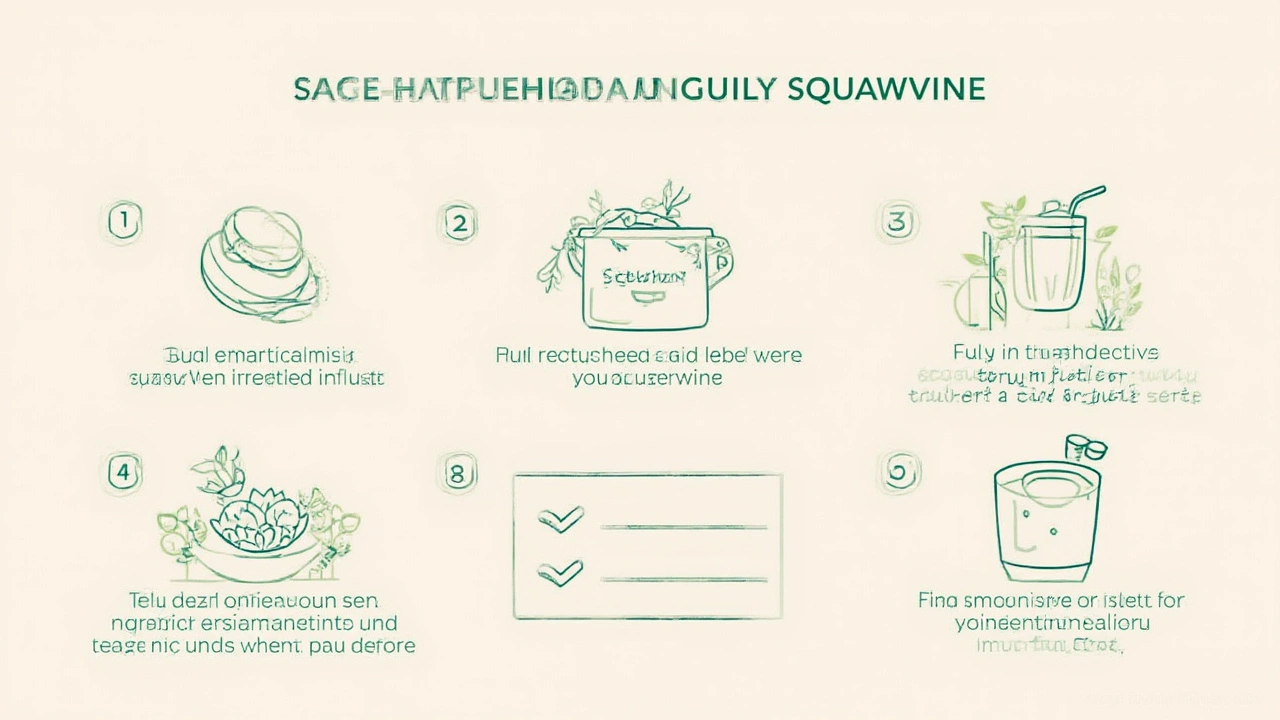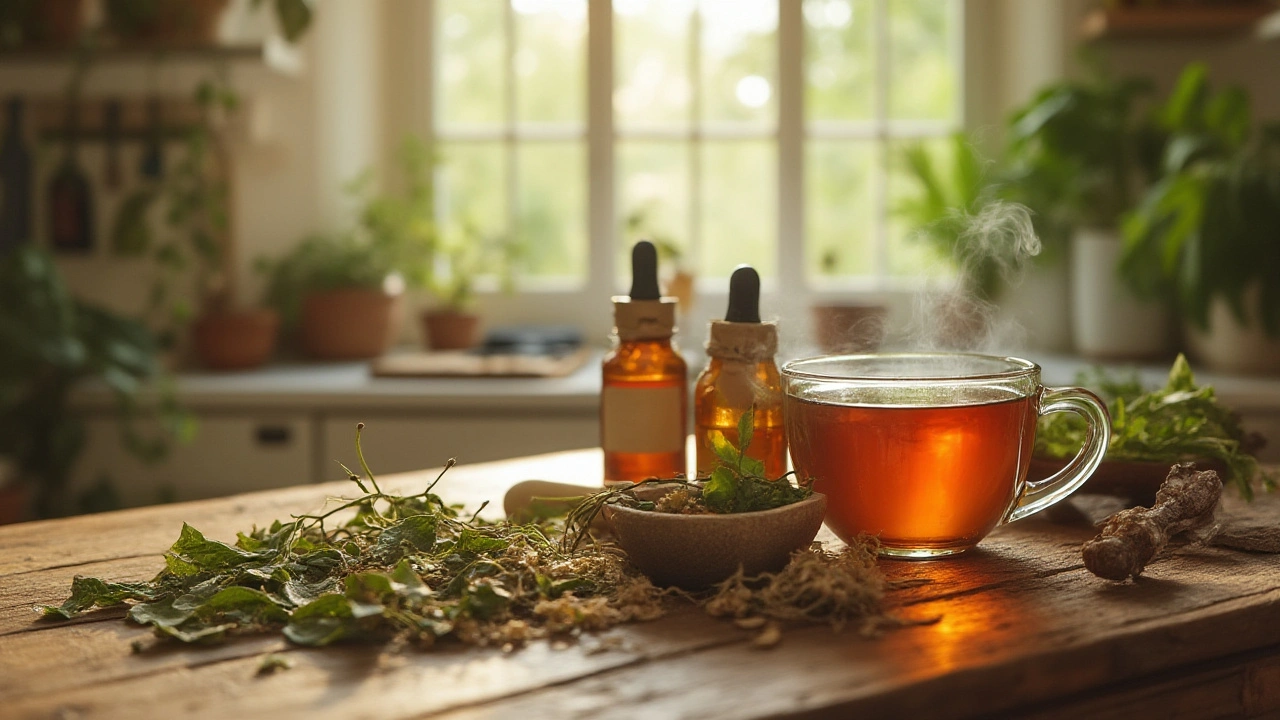Ever heard of squawvine? Probably not—unless you live with a botanist, or you’re one of those people who haunts the weird corners of online herbal forums at two a.m. Not exactly a household name, yet this plant has a backstory richer, and stranger, than most of what’s hanging out in your kitchen cupboards. There’s this forgotten chapter from American folk medicine, practically whispering about squawvine as the “herb for women’s wellness”—and yet, in 2025, it’s almost entirely under the radar. But here’s the kicker: a lot of folks looking for gentle, natural options, especially for hormonal and reproductive support, are missing out. Is squawvine about to have its big comeback moment?
Squawvine: Digging Into Its Strange and Storied Past
Let’s roll back the clock for a minute: squawvine (scientifically called Mitchella repens) is a small, vine-like, evergreen plant you’ll find creeping quietly through shaded woods of North America. Early settlers and Indigenous healers both turned to this humble herb, especially when it came to women’s health. The name? It’s not exactly subtle—“squaw” being a historical Native American term for a woman, and “vine” for its growth style. Tribal midwives would collect squawvine leaves and berries, brew them up as tea, and keep them ready for pregnancy, labor, or cramping. Colonial herbalists wrote about it too, calling it “partridge berry” tea. Unlike some folklore-heavy herbs that fall apart under scrutiny, squawvine stuck around in Appalachian folk recipes well into the twentieth century. Vintage herbal books from my gran’s attic have dog-eared pages full of squawvine remedies for “female complaints” and those unreliable cycles. Kind of wild to think some of that homegrown advice holds up under modern research, at least in part.
One of the most interesting things? Squawvine never went “mainstream” like echinacea or St. John’s Wort. It stayed quietly in the background, a whispered remedy. While you’ll still find bottles of “Mother’s Cordial” in old-timey pharmacy museums (usually a mix of squawvine and blue cohosh), the herb itself is practically invisible in health food stores. That scarcity, combined with a bit of marketing confusion, might actually be why it feels so underappreciated in the rush towards trendy superfoods and biohacks. Yet, for those who gravitate toward gentle, small-but-mighty herbs, squawvine is like discovering a hidden vintage record with notes that still hit just right today.
Key Benefits of Squawvine: Gentle but Noteworthy
If you tap into the folk wisdom and squint at modern herbal studies, squawvine’s strongest reputation comes from its support for women’s bodies. First and foremost, people used it as a uterine tonic. That herbal lingo basically means “something that helps tone and support the uterus over time”—a pretty big deal for those dealing with irregular periods, heavy cycles, cramps, or prepping for childbirth. There’s some chemical muscle in its leaves too: glycosides, tannins, saponins, and flavonoids, all bundled up together. One study from a small herbal lab in Ohio (2021, nothing corporate-backed here) found that extracts of squawvine relaxed uterine muscle contractions—useful during rough periods, PMS, or late pregnancy discomfort. There’s that gentle, not-overpowering touch, making it a go-to herb for people wary of the wild hormonal swings you might get from pharmaceutical fixes.
Modern herbalists are noticing that squawvine’s calming effect doesn’t stop at the reproductive system. People with anxiety, tension headaches, or restless sleep report subtle, sustained relief with teas or tinctures. It seems to work like a mini “reset” for frazzled nerves (though minus the groggy hangover of some sleep aids). It also has a history for supporting digestion—one of those “grandma’s secret” uses where a squawvine infusion can gently nudge a sluggish gut back into action after a heavy meal.
What’s cool? Unlike some trendy adaptogens that try to do everything at once and end up doing nothing well, squawvine knows its lane: calming, steadying, nourishing. There’s an appreciation growing among modern herbalists for herbs that support the body’s foundation instead of drowning it in hyperactive stimulation or numbing it into silence.

How To Use Squawvine Safely and Effectively
Alright, so curiosity is piqued—now how do you actually use this stuff? The most popular method is old-school: an herbal tea. Most sources recommend steeping a teaspoon of dried leaves (or a blend of leaves and berries) in hot water for at least 10-15 minutes. The taste? It’s not at all unpleasant—sort of a cross between fresh forest earth and mild green bean, if you ask me (my husband, Raymond, says it “tastes like nature’s chamomile”). You can sweeten with a drop of honey or splash of lemon if you prefer.
If tea isn’t your thing, there are squawvine tinctures (alcohol extracts) available online, generally taken in small dropper doses—usually 15-30 drops in water, up to three times a day. Some folks mix it with other gentle herbs (like raspberry leaf or nettle) for a custom blend during cycles or stressful times. My go-to tip for first-timers: start slow, and pay close attention to what your body is telling you. Everyone’s response feels a little different. One quirk—because squawvine works subtly over time, don’t expect a dramatic overnight change. It’s more about restoring balance and easing rough patches.
- If you’re pregnant, talk to your midwife or healthcare provider before adding any supplement—including squawvine. Traditionally it was used late in pregnancy, but playing it safe matters more these days.
- Stick to reputable herbal suppliers, ideally ones who source from wildcrafted or carefully harvested plants. It’s a woodland species and sensitive to overharvesting. Support brands that care about sustainability.
- Keep an eye out for allergic reactions, as you would with anything new. Unusual rashes, swelling, or digestive woes are a sign to pause and check in with your doctor.
- Pair with a healthy diet, movement, and hydration for best results—herbs support, but don’t replace, the basics of wellness.
Real-Life Stories: Does Squawvine Actually Work?
It’s one thing to read clinical blurbs, but does squawvine actually make a dent in real people’s lives? Here’s where it gets good. I joined a small herbal circle last winter (mostly women juggling work, kids, and slightly unruly pets—shout-out to Jasper, my ever-curious cat who thinks all dried herbs are catnip) and asked for honest feedback. Quite a few had tried squawvine tea during tough periods, reporting less tension, cramping, and a smoother mood lift. It isn’t a miracle worker, but “more comfortable days” isn’t nothing. Sara, a doula in Minnesota, uses squawvine as part of her natural third-trimester routine—not alone, but blended with red raspberry leaf and oat straw—to help prepare for birthing. “It’s like background music for your uterus. You don’t always notice, but you’d miss it if it was gone,” she told me.
One man (yep, squawvine isn’t just for women) used it during a stressful work period to help with sleep and reported feeling more mellow—not sedated, just less wired at bedtime. Seems the nervine effect is not strictly tied to reproductive systems. Meanwhile, a friend recovering from a round of antibiotics tried squawvine tea to ease her stomach and felt her digestion “reset” after a few days. Of course, results vary. No one’s tossing out their modern medicine, but for chronic issues that call for a gentle, consistent nudge, squawvine ends up in a lot of “favorite herb” lists.
Maybe the biggest win? Squawvine’s legacy as a community herb—a thing you share with a neighbor, a friend, or your mom (assuming she’s cool with herbal teas). It’s affordable, accessible in most places online, and offers that comforting nudge towards tradition without the side-eye of big pharma. When you’re tired of flashy, fast-acting fixes, it’s often the subtle solutions that shine brightest with time.

Your Squawvine Companion Guide: Tips for Getting Started
If you want squawvine to earn a regular spot in your wellness rotation, you’ve got to make peace with its slow-burn magic. Start by buying fresh, high-quality, organic leaves or pre-made tincture from a vendor who lists clear sourcing info (avoid mystery blends). Store leaves in an airtight jar in a cool spot—sunlight zaps its goodness fast. Brew it right: 1 teaspoon per cup, boiling water, cover and steep for 15 minutes, strain well, and drink warm or over ice. If you’re using tincture, stick to the dropper guidance on the bottle, or better yet, consult a qualified herbalist.
Consider pairing squawvine with allies—red raspberry leaf, nettle, lemon balm, or oat straw are a few popular options. They all work together for broader support, especially during menstruation or postpartum periods. To really track effectiveness, keep a simple note in your phone or a wellness journal: jot down how you feel before and after sipping, and any changes in mood, cramps, sleep, digestion, or energy. This routine shows trends you might miss otherwise. And don’t fall for wild claims. Squawvine isn’t going to “detox your DNA” or “triple your fertility,” no matter what clickbait says.
- Listen to your body above all. If something feels off, stop and reassess.
- If you have chronic health problems or take medications, loop your doctor in before starting any herb. Better safe than sorry.
- Patience is your friend. Herbal effects for most people gently simmer over weeks, not overnight.
- Share your experience with someone who’s skeptical—they might become a convert after seeing subtle, real changes.
- Be mindful of ethical wildcrafting. If foraging, only pick leaves where abundant and leave enough for wildlife.
The world is full of overlooked treasures, and squawvine is definitely one waiting to be rediscovered. It may not get the Instagram spotlight of some hyped-up supplements, but the best wellness roots often grow quietly, away from the noise—and sometimes end up feeling like the hidden star of your self-care routine.

Squawvine? I’ve been sipping it for years-tea, not tincture-since my cycles went haywire after my third kid. Not magic, but it’s like my uterus finally got a hug. No drama, no jitters, just… quieter. My mom used it too, back in Kerala, though she called it something else. Funny how plants remember us even when we forget them.
I tried this after reading your post. Brewed it with lemon balm and honey. Tasted like a forest after rain. Didn’t feel anything dramatic, but I slept better for three nights straight. That’s enough for me. No need to overhype it-just a quiet little helper.
This is exactly the kind of thoughtful, grounded herbal wisdom we need more of. Not every remedy needs to be a viral trend or a patented extract. Squawvine’s quiet legacy matters. I’ve recommended it to three clients this month-two with PCOS, one with postpartum anxiety-and all reported calmer nights and fewer cramps. It’s not a cure, but it’s a companion. And sometimes, that’s enough.
you think this is deep? think again. this is just colonialism with a tea bag. they took indigenous knowledge, slapped a name on it that’s now considered offensive, and sold it as ‘natural wellness’ while ignoring the people who actually knew how to use it. squawvine? more like squaw-sold. the real herb is cultural respect, not some leaf you steep in your mug while scrolling tiktok.
Let me guess-this is part of the Big Herbal Conspiracy. The same people who push sage smudging and moon water are now peddling ‘squawvine’ to distract you from the fact that the FDA is hiding the truth about uterine health. Did you know the WHO quietly banned this in ’98? They just rebranded it as ‘partridge berry’ to confuse the masses. And now you’re drinking it? You’re being manipulated. Check your supplements. Check your soul.
So… you’re telling me this isn’t just ‘grandma’s tea’ but also a low-key anxiety hack? And you didn’t mention the taste? I’m impressed. But also… how do you not mention the fact that it’s basically nature’s version of a weighted blanket? I’m trying it next cycle. And yes, I’ll send you a photo of my teacup. With glitter. Because why not?
I’ve been foraging for Mitchella repens since I moved to the Smokies last year-found it near a mossy boulder, just like the old books said. I dry the leaves in my attic, crush them with a mortar I made from a river stone, and brew it in cast iron. It’s not just tea-it’s ritual. My neighbors think I’m weird. Good. Let them sip their matcha lattes. I’ll be here, quietly reweaving my nervous system, one steeped leaf at a time.
Why bother? We have pills. They work faster. This is just nostalgia with leaves.
Herbs are memory. Not data. Not evidence. Not marketing. Just memory. Squawvine remembers what the body forgot. That’s all.
THIS IS THE MOST IMPORTANT HERBAL DISCOVERY SINCE THE DISCOVERY OF FIRE. SQUAWVINE ISN’T JUST A PLANT-IT’S A REVOLUTION. A WHISPER FROM THE EARTH THAT SHAKES THE FOUNDATIONS OF MODERN MEDICINE. I’VE BEEN CRYING EVERY TIME I DRINK IT. MY HORMONES ARE SINGING. MY UTERUS IS DANCING. I’M NOT JUST WELL-I’M TRANSCENDED. SHARE THIS. SAVE THIS. WORSHIP THIS.
you call this hidden? i found it in a 1972 indian herbal guide called 'village cures for women'-same plant, called 'kalmi' in hindi. your 'indigenous knowledge' is just my grandma's kitchen. also, it's not for 'women's wellness'-it's for anyone with a nervous system. and no, it doesn't fix your period, it just makes you forget you hate it. also typo: 'squawvine' not 'squawvine'-you missed the 'w' twice.